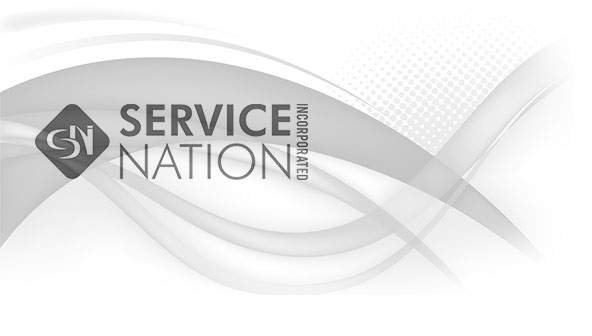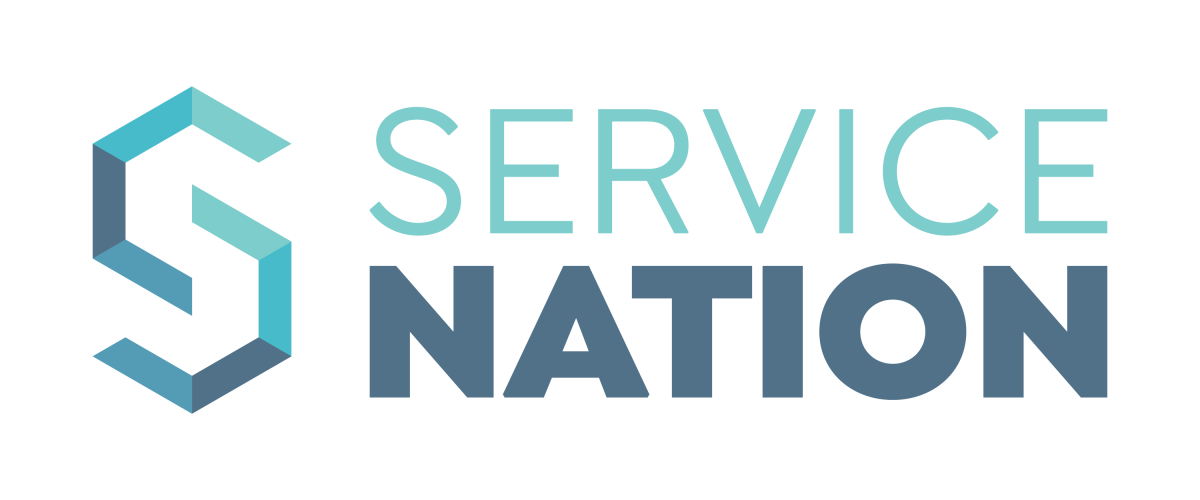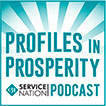
Podcast #95
“What You Don’t Know About Design Can Hurt You”
Featuring Chanda Huff and Anthony Williams
Intro: Welcome to Profiles In Prosperity, the leading podcast for residential service contractors, sponsored by Service Roundtable and hosted by David Heimer.
David Heimer: Hi everybody, this is David Heimer. Welcome to Profiles In Prosperity. Today, I have the great pleasure of introducing you to two really smart, talented people that I get to work with at the Service Nations, Chanda Huff and Anthony Williams. We’re going to talk about something I think that many in our industry don’t pay enough attention to, but makes a huge difference in branding, image, perceived professionalism, recruiting and retention of coworkers. So before I get into all that, let me introduce our guests. Chanda Huff is the Service Nation Graphics Department manager. She’s been with Service Nation for seven years. Anthony Williams is a Service Nation senior graphics designer. He’s also been with Service Nation for seven years. So Chanda and Anthony, welcome to Profiles In Prosperity.
Chanda Huff: Thank you for having us, David.
Anthony Williams: Thanks for having us.
David Heimer: Before we get into this too much, tell us a little bit about what you guys do.
Chanda Huff: I’m the graphics department manager, so I oversee all the designers at Service Nations. So anything worked on for our download center or anything up to our custom graphics projects, I get to see over all the designers for that. And then I also design for our shows, Service World Expo and the International RoundTable, and I also help with in-house projects such as the profit report and other large design projects.
David Heimer: Anthony.
Anthony Williams: Yeah, I’m the senior graphic designer there and I pretty much do Service Nation projects for our alliance members. I do a lot of internal projects and then I do onsite event photography at our conferences.
David Heimer: You do beautiful photography, man. You’re understating it.
Anthony Williams: I appreciate that.
David Heimer: So thank you guys for being here. You know, my background is in computer science, was my major in college, no business, IT, those kind of quantitative things have always been what I focused on. So what I realized after working with you guys is that I had a real lack of sophistication in graphic design and all the beautiful things that you guys do. But after I started working with you guys, I realized what a huge impact what you do has on businesses. You know, it impacts the image of the company, the professionalism, it attracts people to the company, both employees and customers. It’s huge. And so I thought about that and I thought about how I think a lot of people don’t understand the value of what you guys do. And so I think that that means that there’s a lot of people in our industry who could have a slightly better understanding of what you guys do and the benefits of what you guys do. And I think it would help them and it would help their businesses out a whole lot. So I wanted to know, like, if you were talking to contractors, you’ve dealt with a whole lot of contractors over time, what are some of the things that contractors don’t know about what you guys do that would help them and help their business? I know you guys said you’d come up with three topics. So what are they?
Chanda Huff: Well, the first one, we do work with a lot of contractors and big companies, small companies at all sizes. And we see the ones that have the most success are the ones that keep their message or their branding simple. And this is on all their marketing, but specifically on vehicle wraps. So a lot of people, they want to put too much stuff on their wraps. You know, they want the credit card emblems, they want a happy family, they want all their services listed, which we’ve just come to find, if you are advertising, we try to see the vehicle wrap is like a moving billboard. So, you know, you’re flying down on the highway, you’re not going to see every single service listed on this billboard. And that’s basically a vehicle wrap. So our advice would be to keep it simple, meaning putting your logo, your branding colors, a URL of some sort, or maybe a phone number.
David Heimer: So what happens when there’s so much information on there? As you said, I’ve seen these as well. They’ve got pictures, they’ve got equipment, they’ve got a lot of words. I’ve seen some where they list every single service that they do, like they’re hoping to get paper click or something from the – Google recognition from their van. So what happens when you’ve got this overload of information there?
Anthony Williams: They’ve had some research that has shown that when you hit a human eye with so much information that the eye kind of just glances over everything and nothing is actually retained. So when you put all that stuff on there, you’re just diluting your message and nothing actually ends up being remembered by the potential customer.
Chanda Huff: The idea that we would like to, I guess, suggest is keeping it more simple. That way, you’re basically just wanting to drive people to your website from your vehicle wrap, or drive people to know your branding. So you’re able to be recognized, but you don’t have to list everything that you do. Your website should list everything that you do, definitely, but your vehicle wrap and your marketing is just all driving it to one central spot.
David Heimer: That makes sense. You know, it’s interesting, one of the things that I’ve heard a lot from our customers, after you guys design their vehicle wrap and after they actually do the wrap, people say, I see your vehicles all over the place. And our customer, our members will say, I have no more vehicles than I had before, but for some reason, people see me now. Is that part of keeping it simple?
Chanda Huff: You’re definitely going to notice a particular wrap more than you would a white unmarked van, and that’s a whole other podcast for another time. But definitely, you’re going to notice a wrapped vehicle just because it’s eye-catching and everyone else who just has an unmarked van, you see thousands of them on the roads and you just don’t realize it.
David Heimer: Alright. So good stuff. Keep it simple. What else?
Anthony Williams: The second one we wanted to go over was just to stand out in your own market and really try to be unique. Obviously, in this industry we have a lot of red and blue –
David Heimer: Red, white and blue.
Anthony Williams: The patriotic theme is always popular and and we’re definitely not saying you can’t go with that, but just a little bit of a realization that if you look around and all of your competitors are using red and blue as their branding, that it’s not a bad idea if you could maybe step away and use different colors.
David Heimer: So do you have any good examples of that?
Chanda Huff: Not a company that we did the wrap on per se, but Jerry Kelly is one. He took this purple color and made it his own and no other company in his industry had purple at the time. So he was then recognized as the purple trucks. So just really taking a color that’s not in your market. If everyone has red, then yes it would be great to use blue. I think we want to get away from the notion that you have to use red and blue to signify that you have heating and cooling. And people will do it in their logos. They say, you know, I want heating in red and cooling in blue. I think most people realize what those colors –
David Heimer: There’s a lot of that.
Chanda Huff: Yes, there is. And we want them to realize that you can step out of that and have your branding in a different color and people will still know that you do air conditioning and heating.
David Heimer: Yeah, there’s a lot of red, white and blue. Red for heating, blue for cooling, white because red, white and blue is patriotic in the US. And then in plumbing, there’s a ton of blue because of water. So what are some great colors? Have you seen anything? We talked about Jerry Kelly doing purple. Anything else that you guys have seen? Anything with our members that really pops for you guys?
Chanda Huff: Southern Air.
David Heimer: Oh, yeah.
Chanda Huff: Big orange truck with a green shield emblem, I think that one always stands out for me. And their wraps are very vivid.
David Heimer: They use that orange everywhere. They’ve got – Dustin wears a bright orange shirt, you can see them a mile away. It really pops, doesn’t it?
Chanda Huff: It’s definitely noticeable for sure. I mean, that safety orange for sure just really stands out for you.
David Heimer: What were you going to say Anthony?
Anthony Williams: We’ve also done one for Ado up in Canada, and they also use purple predominantly. And he’s also got a wizard as his mascot, so you can’t get much farther away from heating and cooling with a purple wizard. But he’s found a way to make it work and he’s been really successful with it.
David Heimer: Yeah, that one’s another one. And you guys did the design on that one as well. It’s really beautiful, it really stands out. Nice job on that. Okay, so keep it simple, stand out, use different colors than everybody else. Are there any other ways that people can stand out and be unique in their design?
Anthony Williams: You could always add a mascot or something like that to go along as a companion with your logo. A lot of the imagery that we see with the logos in our industry tends to be suns and snowflakes.
David Heimer: Drops of water. Yeah.
Anthony Williams: Drops of water.
Chanda Huff: A pipe, wrench –
Anthony Williams: Pipe. Yeah. But things don’t have to be taken so literally, there’s a lot of other things that you can use. Pretty much, literally, almost anything you can use to brand yourself.
Chanda Huff: One of the examples I used to give in boot-camp was we had a company that had a big red old truck, I think it was like an older Ford, and it was in front of their shop at the time. And that’s kind of how they became known as the heating and air conditioning company with a red Ford out front. So we took that truck and we modeled their entire branding after it and it is now in their logo and, you know, they’ve rebranded their trucks with it and business cards, flyers, their whole social media now has this big red truck because that’s what they were already known for. So why not use that as a ploy in their marketing.
David Heimer: Yeah, great idea. Alright. So colors, the different kind of avatar, I guess. Is that what you would call it?
Anthony Williams: Yeah. Like an avatar or a mascot.
Chanda Huff: Yes.
David Heimer: Mascot, avatar. Great. So one of the things I’ve noticed that you guys do on van wraps is you sort of tilt the van wrap a little bit. Why is that?
Chanda Huff: Sometimes it really just depends on the logo. Not all logos look great tilted, I’m not going to lie. But sometimes to just get a new perspective on it and sometimes to avoid certain lines in the vehicle wrap, it just looks better tilted at times. It definitely draws the eye.
David Heimer: Yeah, people notice things that are different, right? Our minds are taught to ignore stuff that is the same and we have evolved to notice things that are different. If something is moving or if it isn’t symmetrical or if it is off kilter a little bit, we have to look at it.
Chanda Huff: Yes, I would definitely think that as well.
David Heimer: Okay. So keep it simple, stand out. What’s your third item?
Chanda Huff: When you are looking to rebrand, keep an open mind. We see a lot of people who say that they would like to rebrand and they want a new logo, they want a fresh look. However, after we give them some options, they realize, they don’t want to completely rebrand. They get emotionally attached to their logo because they’ve had it and their family or maybe they themselves have made this logo. But you know, there is a reason why they’re wanting to rebrand. So I guess we want to let them know to keep an open mind and really feel like letting go of their old branding altogether.
Anthony Williams: Yeah, the emotional aspect seems to take a lot of them by surprise when it comes down to really changing things. So we try to just kind of hold their hand and remind them that it’s okay for this to evolve a little bit. It doesn’t always have to stay the same.
Chanda Huff: And we’ve seen people that have completely let go of their old branding and really been open to a new concept. And, you know, we’ve seen a lot of these companies come up with a big increase in revenue. And there are some preferred partners of ours that have really done the stats on these and some as much as like 1200% increases in revenues over like the five years after rebranding. Just some ridiculous numbers on crazy, crazy increases that have really helped it, and it’s really due to their marketing.
David Heimer: That’s interesting. I hadn’t really thought about that. People do get attached to logos and I’ve seen some, not necessarily in our industry but outside of our industry as well, where the logo changed dramatically over time and I don’t think people lose business because they rebrand. Do they?
Chanda Huff: I wouldn’t think so, unless it’s just provocative in some way. But no, I would think it would help business.
David Heimer: Assuming the new brand is pretty good, companies don’t lose business because they have gotten rid of their old logo.
Chanda Huff: Right, exactly.
David Heimer: So do you guys have any good examples of that?
Chanda Huff: One that comes to mind is Eagle Pipe Mechanical. They had a logo, and I don’t even remember what it looked like, but it was very dated at the time and they came to us and they let us redo it and they were very open and wanted to see new changes and open for anything and they really liked a concept that we gave them and we’ve gone forward with them. And now they have rebranded their trucks, they rebranded a lot of their marketing. And I think it looks great, to be honest.
David Heimer: Me too. That’s Laurie Shoals company, and trucks and the logo look fantastic. You guys did a great job.
Chanda Huff: Well, thank you.
David Heimer: Well, thank you guys for doing this. I think it’s really interesting, what you guys do makes such a huge difference. There are companies where the employees feel better about themselves, they feel better about the company because they’re working with a company that has a more modern image. And really, it’s because of the work that you guys do. So way to go.
Chanda Huff: Well, thank you. We’re happy to be a part.
Outro: We’re always looking for good ideas and interviews for our podcast. If you have an idea or maybe you think you should be interviewed, just shoot an email to profilesinprosperity@serviceroundtable.com, that’s profilesinprosperity@serviceroundtable.com. If you think what we’re doing has any value, it would be very helpful if you would give us a great rating on iTunes. Thanks for your support. Hope to see you again soon. Bye.




 (877) 807-0869
(877) 807-0869 Member Login
Member Login

